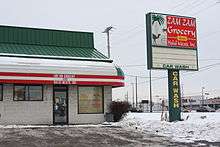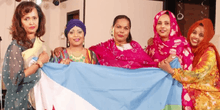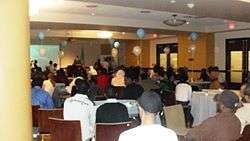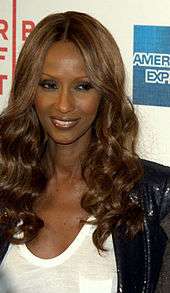Somali Americans
Somali Americans are Americans of Somali ancestry. The first ethnic Somalis to arrive in the U.S. were sailors who came in the 1920s from British Somaliland. They were followed by students pursuing higher studies in the 1960s and 1970s, by the late 1970s through the late 1980s and early 1990s more Somalis arrived. However, it was not until the mid and late 1990s when the civil war in Somalia broke out that the majority of Somalis arrived in the United States. The Somali community in the U.S is now among the largest in the Somali diaspora.
| Total population | |
|---|---|
| 135,266 (total Somali ancestry);[1] 76,205 (Somalia-born)[2] | |
| Regions with significant populations | |
| |
| Languages | |
| Religion | |
| Islam |
History
The earliest ethnic Somali immigrants to the United States were sailors who arrived in the 1920s, mainly from British Somaliland. Eventually acquiring American citizenship, they actively participated in the Somali independence movement and served as key liaisons whenever Somali political figures visited the UN headquarters. For their substantial contributions to Somali society, these early Somali expatriates were rewarded with medals by the Somali government and some were also issued land back home. Following independence in 1960, Somali students began arriving in the US to pursue higher studies while living with relatives or on scholarships. Many of the youngsters returned to Somalia after graduation and went on to play an important role in the development of their nation. During the 1980s, a small number of Somalis settled in the United States. They were later joined by many other ethnic Somalis from different backgrounds, who sought asylum in the US after the outbreak of the civil war in Somalia or emigrated from other parts of Greater Somalia.[3]

A large number of the Somali immigrants settled in Minnesota, which in 2002 harbored the largest population of Somalis in North America.[4] Many of the newer arrivals came through voluntary agencies (VOLAGS) contracted with the State Department, who helped them settle in.[5][6] By 2006, Somalis in the state accounted for $164–$394 million in purchasing power and owned 600 businesses.[7] The city of Minneapolis in particular hosts hundreds of Somali-owned and operated commercial ventures. As of the 2015 American Community Survey, there are 57,000 residents in the state who are of Somali ancestry, among whom 31,400 were born in Somalia.[8]
Somalis in the United States often send resources to their extended families abroad, remittances that were facilitated by the signing of the Money Remittances Improvement Act.[9] Following a greatly improved security situation in Somalia in 2012, many Somali U.S. residents have also begun returning to Mogadishu and other parts of the country.[10] A few of the homeward-bound immigrants along with some American-born associates have been sought and/or prosecuted for allegedly providing material support to the Al-Shabaab and Islamic State political militant groups.[11][12] However, according to intelligence officials, fewer expatriates were joining the groups' ranks by late 2013.[13][14] Most of the returnees have instead repatriated for investment opportunities and to take part in the ongoing post-conflict reconstruction process in Somalia. Participating in the renovation of schools, hospitals, roads and other infrastructure, they have played a leading role in the capital's recovery and have also helped propel the local real estate market.[10]
Demographics

Current estimates of the number of Somali immigrants living in the United States vary widely, ranging from 35,760 to 150,000 persons.[15] 2010 American Community Survey data indicates that there are approximately 85,700 people with Somali ancestry in the US. Of those, around 25,000 or one third live in Minnesota;[16] 21,000 of the latter were born in Somalia.[17] Nationwide, 76,205 were Somalia-born.[2] Somalis are the largest Cushitic groups in the United States.
The largest concentration of Somalia-born people in the United States is in the Minneapolis-St. Paul-Bloomington area of Minnesota (47,320). The next largest concentrations of Somalis are in Columbus, Ohio (40,280), Seattle, Washington (31,850), San Diego-Carlsbad-San Marcos in California (27,845), Washington, D.C.-Arlington-Alexandria in the Virginia-D.C. area (2,715), Atlanta-Sandy Springs-Marietta in Georgia (2,305), Phoenix-Mesa-Glendale in Arizona (1,965), Portland-Vancouver-Hillsboro in Oregon (1,480), Nashville-Davidson-Murfreesboro-Franklin in Tennessee (1,420), Boston-Cambridge-Quincy in Massachusetts (1,380), and other areas (28,650).[2]
In 2014, the Minneapolis City Council passed a resolution marking July 1 as Somali American Day. The event commemorates the Independence Day of Somalia, which is annually celebrated on the same day.[18] The council also approved a resolution making Minneapolis and Bosaso in northeastern Somalia sister cities.[19] Additionally, the Federal Government of Somalia announced that it would start officially keeping count of Somalis abroad.[20]
Employment
Many Somali refugees in the US have experienced difficulties accessing the labour market. According to the 2010 census, 47% of Somalis in Minnesota were employed, 13% unemployed and 40% were economically inactive. By comparison, the unemployment amongst the state's overall foreign-born population was 6%. The unemployment rate of Somalis in Minnesota is, however, significantly lower than amongst Somali populations in places including London and Toronto.[21] At the national level, survey data over the period 2011 to 2015 shows that 58% of working Somali Americans were employed and 5.1% self-employed, compared to 26% and 0.7% of working-age Somalis in Sweden.[22]
Community organizations

The Somali community in the United States is represented by various Somali-run organizations. Somali Community Services in San Jose and the Somali American Council of Oregon (SACOO) on the west coast offer guidance to new Somali families and works closely with the municipal authorities to strengthen civic relations.[23][24] The Somali Community Access Network (SomaliCAN) is one of several groups serving Columbus' Somali community.[25] In Minnesota, the Confederation of Somali Community in Minnesota (CSCM), Somali American Parent Association (SAPA), and Somali Action Alliance also offer various social services to the state's resident Somalis.[23][26][27]
Politically, a Somali American Caucus in the Minnesota Democratic–Farmer–Labor Party (DFL) was formed to represent the Somali community.[28] A Somali American also chairs the Republican Party's Immigrant Relations Committee in Minnesota.[29]
Diplomatic missions
Somalis in the United States are represented by the embassy of Somalia in Washington, D.C.[30] The embassies of Djibouti and Ethiopia in the capital provide additional diplomatic representation for resident ethnic Somalis.[31] also the self declared republic of Somaliland maintains a representative office in Washinghton.
Notable people
- Mohamed Abdullahi Mohamed, diplomat, professor and politician; President of Somalia
- Ilhan Omar, congresswoman, first Somali American elected to US House of Representatives
- Dahir Adan Elmi Chief Commander of Somali National Army 2000s
- Mohammad Ali Samatar Former Somali Prime Minister 1987-1990
- Ali Khalif Galaydh Somali Politician and Former Minister 1980s
- Yussuf Salhan Former Somali Deputy Defense Minister 1979-1982
- Abdiweli Mohamed Ali, An Economist, Former Somali Prime Minister

- Abdinur Sheikh Mohamed, educator and politician; former Minister of Education of Somalia
- Abdirahman Duale Beyle, economist; former Minister of Foreign Affairs of Somalia
- Abdisalam Aato, film director, producer, entrepreneur and media consultant; founder of Olol Films
- Abdisalam Omer, economist; Minister of Foreign Affairs of Somalia
- Abdullahi Ahmed Irro A Profesor and retired former Somali General
- Alisha Boe, actress
- Asha Ahmed Abdalla, politician; former member of the Transitional Federal Parliament
- Asli Hassan Abade, military pilot
- Ayaan and Idyl Mohallim, fashion designers; founders of Mataano
- Ayaan Hirsi Ali, writer, political activist, former legislator
- Halima Aden, supermodel
- Hassan Ali Mire, politician; former Minister of Education of Somalia
- Hodan Ahmed, political activist
- Fatima Jibrell, environmental activist; co-founder of Adeso
- Idil Ibrahim, film director, producer and entrepreneur; founder of Zeila Films
- Iman, supermodel, actress and entrepreneur
- Jawahir Ahmed, fashion model and beauty pageant winner
- Muna Khalif, fashion designer and legislator; MP in Federal Parliament of Somalia
- Musse Olol, social activist; Recipient of the 2011 Director's Community Leadership Award
- Nuruddin Farah, writer
- Raqiya Haji Dualeh Abdalla, sociologist and politician; President of the Somali Family Care Network
- Saado Ali Warsame, singer-songwriter and politician
- Said Sheikh Samatar, scholar, historian and writer
- Sofia Samatar, professor, editor and writer
See also
- Somali diaspora
- Dalmar TV, a Somali-language television network
- History of the Somalis in Minneapolis–Saint Paul
References
- Bureau, U.S. Census. "American FactFinder - Results". factfinder.census.gov. Archived from the original on 19 July 2018. Retrieved 10 March 2018.
- "Ten Largest African-Born Countries of Birth in the United States by Selected Metropolitan Statistical Areas: 2008–2012" (PDF). US Census Bureau. Retrieved 4 December 2016.
- Diana Briton Putman, Mohamood Cabdi Noor (1993). The Somalis: Their History and Culture. Center for Applied Linguistics. p. 1.
- "New Americans in the North Star State" (PDF). Immigration Policy Center. American Immigration Council. Archived from the original (PDF) on 4 November 2009. Retrieved 30 October 2017.
- "2014 MAA-CBO Directory" (PDF). Minnesota DOH. Archived from the original (PDF) on 31 October 2017. Retrieved 11 January 2018.
- Abdi, Cawo Mohamed (2019). "The Newest African-Americans?: Somali Struggles for Belonging". In Armila, Päivi; Kananen, Marko; Kontkanen, Yasemin (eds.). The Contexts of Diaspora Citizenship: Somali Communities in Finland and the United States. Cham: Springer. pp. 19–32. doi:10.1007/978-3-319-94490-6_2. ISBN 9783319944890.
- "Economic Contributions of Somalis in Minnesota" (PDF). Archived from the original (PDF) on December 30, 2008.
- "Immigration & Language". Minnesota State Demographic Center. Retrieved 2 January 2018.
- "Ellison and Paulsen Reintroduce Money Remittances Improvement Act To Help Somali Families Send Money Home". House Office of Keith Ellison. 6 May 2014. Archived from the original on 26 August 2014. Retrieved 26 August 2014.
- "SOMALIA: Returning diaspora help rebuild". Heegan Times. Archived from the original on April 20, 2013. Retrieved 19 February 2015.
- Moran, Greg (31 January 2013). "Terror Trail of 4 Somalis Begins". San Diego Union Tribune. Archived from the original on March 14, 2016. Retrieved 8 February 2013.
- Forliti, Amy (21 April 2016). "Feds: Minnesota men spoke of terrorist attacks in US". The Big Story. Associated Press. Retrieved 1 May 2016.
- "Al-Shabaab Recruits in the U.S." CNN. 23 September 2013. Retrieved 28 September 2013.
- "Report: ISIS publishes 'kill list' for Minnesota police officers". Washington Examiner. Retrieved 8 May 2016.
- "Tuberculosis (TB) - CDC" (PDF). www.cdc.gov. 27 July 2017. Retrieved 30 October 2017.
- "Survey: Nearly 1 in 3 US Somalis live in Minnesota". MPR. Retrieved 4 October 2016.
- "The Foreign-Born Population From Africa: 2008–2012" (PDF). U.S. Census Bureau. Retrieved 4 October 2016.
- "Minneapolis celebrates first Somali-American Day". Minnesota Public Radio. 1 July 2014. Retrieved 30 October 2014.
- "Minneapolis City Council Approves New Sister City In Somalia". CBS. 10 October 2014. Retrieved 30 October 2014.
- "SOMALIA: Gov't to launch population census ahead of 2016 elections". Koonfurta. 10 October 2014. Archived from the original on 30 October 2014. Retrieved 30 October 2014.
- Kananen, Marko; Haverinen, Ville-Samuli (2019). "Facts and figures: Somalis in Finland and in the United States". In Armila, Päivi; Kananen, Marko; Kontkanen, Yasemin (eds.). The Contexts of Diaspora Citizenship: Somali Communities in Finland and the United States. Cham: Springer. pp. 3–18. doi:10.1007/978-3-319-94490-6_1. ISBN 9783319944890.
- Carlson, Benny; Chambers, Stefanie (23 May 2017). "A Tale of Twin Cities and Somalis being Trumped". MinnPost. Retrieved 27 April 2020.
- "Member Organizations" (PDF). National Network for Arab American Communities. Retrieved 4 November 2014.
- "FBI Honors Local Somali American with the Director's Community Leadership Award". Federal Bureau of Investigation. Retrieved 9 February 2013.
- "SomaliCAN - Our Mission". Somali Community Access Network. Retrieved 9 February 2013.
- "CSCM - About Us". Confederation of Somali Community in Minnesota. Retrieved 9 February 2013.
- "Somali American Parent Association". Somali American Parent Association. Retrieved 9 February 2013.
- "Somali American Caucus". Minnesota Democratic–Farmer–Labor Party. Archived from the original on 23 January 2013. Retrieved 9 February 2013.
- Shah, Allie (13 October 2012). "Somali-Americans begin making mark on local politics". Star Tribune. Retrieved 9 February 2013.
- "Ex-Somalia PM named as new ambassador to US". Garowe Online. 11 July 2014. Archived from the original on 9 August 2014. Retrieved 12 July 2014.
- "List of Embassies" (PDF). Office of the Secretary. Retrieved 4 November 2014.